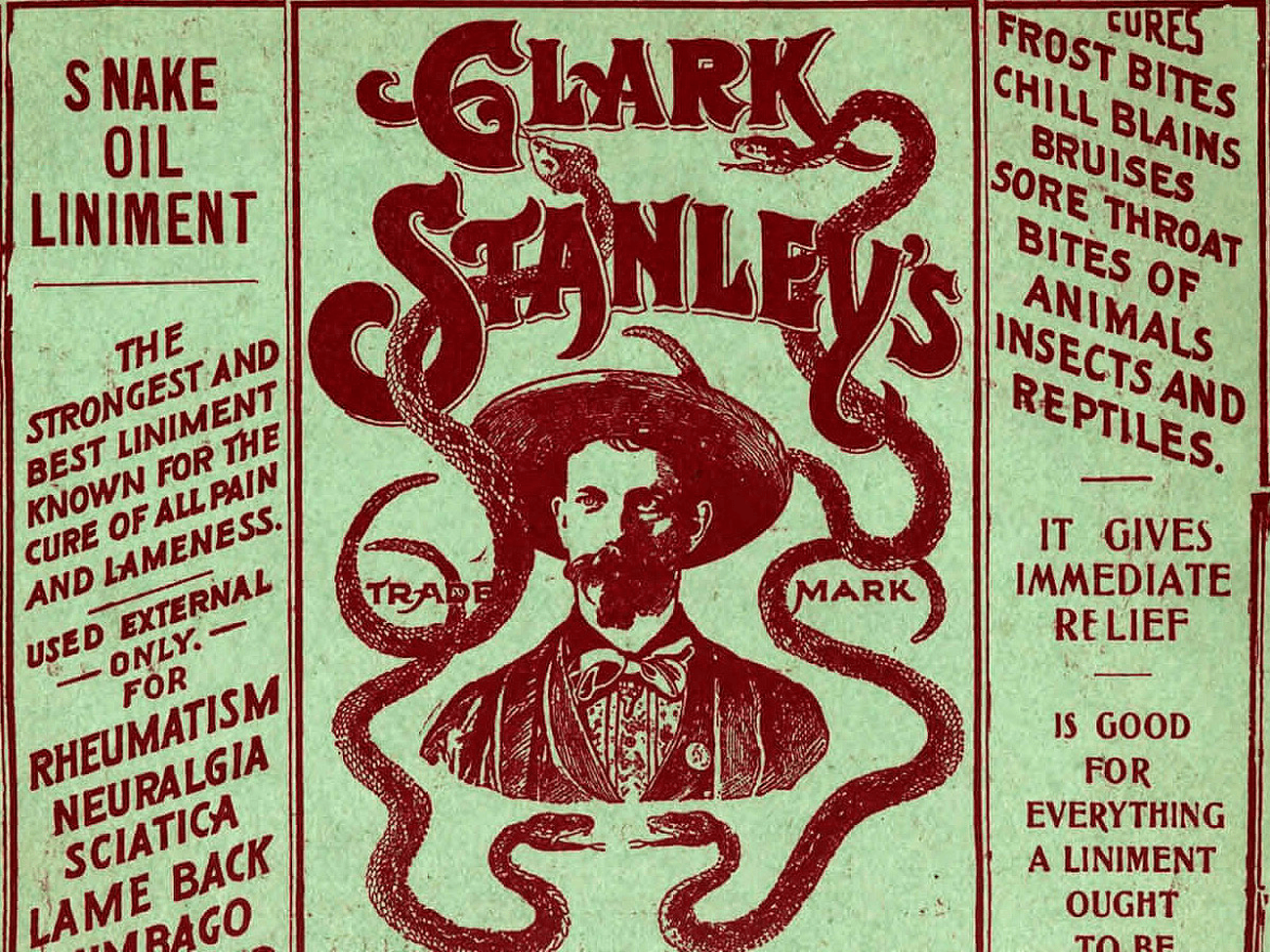If you really want to insult a marketer, there are a few choice slurs you could say about their work that cut deep.
“Clickbait.”
“Spam.”
“Bait-and-switch.”
“Junk mail.”
And most cutting of all: “Snake oil.”
Listen to this story, or continue reading below:
That last one hurts. To imply that someone is hawking snake oil is to not only call their product low-quality garbage, it implies that they are knowingly defrauding customers to sell them this junk. It brings to mind images of a smooth-talking salesman, who through showmanship and slight-of-hand, promises to fix all manner of problems with a product that will do no such thing.
But where does that term come from? Why is “snake oil” synonymous with junk?
The story behind that simple phrase, which evokes such strong emotions, is a delightful marketing tale that gets more complicated the more you dig into it. It’s a story of a cowboy, a socialist, and Teddy Roosevelt—the setup for some awful joke from your Dad—and how all three of their stories intertwined like a Quentin Tarantino movie.
The whole ordeal is a powerful lesson in marketing honesty that still has ramifications to this very day.
You ready? Saddle up, cowboy.
Chicago, 1893
 In 1893, the world turned its eyes to Chicago.
In 1893, the world turned its eyes to Chicago.
A mere 22 years after it was ravaged by a great fire, the city hosted the Chicago World’s Fair, a spectacle seen by 27 million people across its six-month run. The exhibition saw the launch of iconic brands like Juicy Fruit gum, Cream of Wheat, and Pabst Blue Ribbon beer. It launched the careers of musicians like Scott Joplin, who forever changed the music world by popularizing ragtime music. The Chicago World’s Fair even brought us the Ferris Wheel. So highly regarded is the event in Windy City history, that it’s been memorialized with a red star on the city’s flag. Even the World Champion Chicago Cubs don’t get that honor.
To put it lightly, the Chicago World’s Fair was the marketing extravaganza that SxSW could only hope to be.
And in the middle of that pageantry was a self-described cowboy and “Rattlesnake King” by the name of Clark Stanley. He had rolled into town to sell one thing to the revelers at the Fair: Snake Oil.
He did so with great fanfare and showmanship, deftly grabbing rattlesnakes from his bag, slicing them open, and dropping them into a great vat of boiling water. As the snake’s fat rose to the top, he skimmed it off, mixed it with a concoction of patented ingredients, bottled it, and sold it as Clark Stanley’s Snake Oil Liniment—”Good for Everything a Liniment Ought to Be Good For.”
With his penchant for stagecraft, Stanley launched a snake oil empire, selling the bottles for $0.50 each.
But though he was ignorant of it at the time, his business would be unwittingly taken down in the next decade by a socialist author who, just a few miles up the road in Chicago’s famous stockyards, launched an investigation that shocked the country.

Snake Oil—An Actual Thing
Long before it became synonymous with quackery, snake oil was a real medicinal substance that was potentially effective.
The construction of the Transcontinental Railroad in the 1800s brought thousands of Chinese immigrants to the American West and Pacific Coast, and they brought many traditional medical remedies with them. This included snake oil.
Chinese snake oil came from the Chinese water snake—a mildly venomous snake frequently found in Asian rice paddies. This particular breed of snake was rich in omega-3 fatty acids, which we now know is a potent anti-inflammatory agent. Chinese water snakes were even richer in this fatty-acid than salmon. It is conceivable then that oil extracted from Chinese water snakes could be effective at combating inflammatory diseases. However, Chinese water snakes are not found in the American West—rattlesnakes were. And rattlesnakes had a much lower concentration of omega-3s than either water snakes or salmon.
Enter Clark Stanley, a self-described cowboy from Texas. According to the man himself, Stanley had spent years conquering the West—conquests he detailed in pamphlets that also happened to serve as advertisements for his Snake Oil Liniment (how’s that for some content marketing?).
In his writings, Stanley claimed to have learned of the powers of snake oil for medicinal purposes from the Hopi people, though no independent sources can verify this. While plausible, he may have actually picked up the idea of snake oil from Chinese rail workers.
Stanley recounted tales of Hopi “snake dancers” who stared deadly rattlesnakes in the face without fear, as well as his own snake-wrangling, cattle-driving, and card-playing ability—fortifying his cowboy résumé. All of this played an important role in his sales pitch. He was building a brand.
At the Chicago World’s Fair, Stanley made a show of handling the snakes and harvesting their oil in front of a crowd. The Wild West had a special appeal to the general public, who crowded around Stanley’s booth to catch a glimpse of his colorful cowboy get-up and deadly rattlesnakes. Business was booming.
The Wild West had a special appeal to the general public, who crowded around Stanley’s booth to catch a glimpse of his colorful cowboy get-up and deadly rattlesnakes. Business was booming.
Eventually, he met a druggist from Boston who convinced him to move east and open a manufacturing facility to sell his product in bulk. A newspaper interview from an 1896 issue of the Topeka Daily Capital recounted how Stanley fearlessly handled the snakes in his Massachusetts office, telling the reporter how he makes the liniment over the winter, then spends the rest of the year traveling from town to town with his family to sell it.
“No,” he answered, in reply to a “perfectly natural question.” “I am not In the least afraid of being bitten. In fact, I have been bitten hundreds of times. Look here!” he went on, holding out his hands. They were covered with little white scars. “Every one of those,” he said, “is a snake-bite. Some of them are poisonous, some not.”
Later, around 1901, Stanley moved his headquarters to an even larger facility in Rhode Island, still printing his cowboy tales in pamphlets, always accompanied by ads for his product.
But in five short years, a book would be published by a socialist activist that would lead to the end of Stanley’s growing business.

Upton Sinclair—Accidental Food and Drug Whistleblower
In the early 1900s, a socialist author and activist began an investigation and exposé that he hoped would shock the country and force the government to pass new regulations to protect people from poor conditions.
He succeeded, just not exactly in the way he had intended.
Upton Sinclair went undercover in Chicago’s stockyards to investigate the exploitation of poor immigrant workers at the hands of the powerful meatpacking businesses. He described in heartrending detail the long hours, dangerous work conditions, wage theft, and predatory lenders who preyed on a Lithuanian family who had come to America in search of a better life.
His work, which he titled “The Jungle,” was first published in the socialist newspaper Appeal to Reason. The work was republished as a book the next year and became a runaway hit.
The public was shocked. Outraged. Disgusted. They couldn’t believe how unsanitary the slaughterhouses that provided them with meat were!
 That’s not quite the reaction Sinclair was looking for. He had hoped to rally the country around the rights of the working class, forcing the federal government to push through regulations that protected these vulnerable workers. But if food safety caught the public’s attention and spurred some change for the better, he’d take it. Perhaps in the process, some changes could be made for the working class as well.
That’s not quite the reaction Sinclair was looking for. He had hoped to rally the country around the rights of the working class, forcing the federal government to push through regulations that protected these vulnerable workers. But if food safety caught the public’s attention and spurred some change for the better, he’d take it. Perhaps in the process, some changes could be made for the working class as well.
Of this unexpected reaction, Sinclair said “I aimed at the public’s heart and by accident I hit it in the stomach.”
Still, the public outcry—and the endless barrage of letters from Sinclair himself—was enough to force Teddy Roosevelt (who had previously described Sinclair as a “crackpot”) and his administration to pass two important pieces of legislation: The Meat Inspection Act and the Pure Food and Drug Act of 1906.
And it was this latter measure that caused a big problem for Clark Stanley and his snake oil.
The FDA Comes Knocking
With the passage of the Pure Food and Drug Act, the government finally had some teeth with which to crack down on hucksters of phony “patent medicines.” The Act would later evolve into the modern day Food and Drug Administration in 1930, but at the time it only applied to food and drugs moving in interstate commerce.
While other laws had provided some protections, the Pure Food and Drug Act defined “misbranding” and “adulteration” for the first time—stating that a drug would violate the law if it is “falsely labeled in any respect.”
That’s where Clark Stanley ran into trouble.
It took another decade for the government to catch up to him, but in 1916, a shipment of his Snake Oil Liniment was seized by the District Attorney and tested by the Bureau of Chemistry. They found Stanley’s miracle cure was nothing more than mineral oil, 1% fatty oil (probably beef fat), capsicum, and a trace amount of camphor and turpentine.
Not a drop of snake oil to be found.
The D.A. took issue with the claimed uses on the bottle, and concluded that Clark Stanley’s Snake Oil Liniment was misbranded. Their decision did not mince words:
“The article was misbranded for the reason that certain statements, appearing on the label…and included in the booklet accompanying it, falsely and fraudulently represented it as a remedy for all pain and lameness, for rheumatism, neuralgia, sciatica, sprains, bunions, and sore throat, for bites of animals and reptiles, for all pains and aches in flesh, muscle and joints, as a relief for tic douloureux, and as a cure for partial paralysis of the arms and of the lower limbs, and as a remedy for paralysis and effective to reduce enlarged joints to their natural size, as a perfect antidote to pain and inflammation, and effective to kill the poison from bites of animals, insects or reptiles, and heal the wounds resulting from bites of animals, insects, or reptiles, when, in truth and in fact, it was not.”
On June 15th of that year, Clark Stanley pleaded no contest to the charges, and was fined $20—the equivalent of $459.27 today.
But the ramifications of the Pure Food and Drug Act were much larger. After several amendments, the Act eventually became the FDA, a powerful government office with a $4 billion annual budget, charged with protecting the health and safety of Americans.
The FDA works to ensure that food, pharmaceutical, dietary supplement, and over-the-counter medicine manufacturers represent their products in an honest way, preventing the kind of dishonest marketing that Clark Stanley was known for.
“The Bureau of Chemistry (which oversaw the Food and Drugs Act) interpreted the misbranding provision to apply to false therapeutic claims,” says Dr. John Swann, a historian at the FDA. “And at least until a Supreme Court decision a few years later made that interpretation more difficult to enforce, some of the outrageous claims made by patent medicines were removed.”
The formation of the FDA was part of a larger movement—the “Progressive Era”—that saw a push towards more protections for consumers against unfair business practices. In 1914, the Federal Trade Commision was formed, which would be responsible for enforcing false advertising laws, preventing other businesses beyond the food and drug industry from misbranding their products.
Clark Stanley Disappears
$459.27 is a pretty manageable fine for most businesses, provided Stanley gets on the straight and narrow updates his marketing to be more truthful.
Apparently, the Rattlesnake King didn’t find the truth to be all that profitable, because he disappeared after 1916.
“We don’t know what happened to him, and believe me, we’ve looked!” said hoax investigator Joe Nickell when I reached him by phone in his office. “Clark Stanley is something of a mystery. We’ve not been able to find him and track him genealogically.”
Stanley stayed out of the spotlight (and away from the Feds) for what seems like the rest of his life. According to Nickell, we don’t even know if Clark Stanley was his real name, or whether it was simply a stage name for his snake-wrangling cowboy persona. Historians don’t even know the name of his wife and children—just that Stanley mentions a daughter in that 1896 newspaper interview, who he describes as “fearless and expert as he is” at handling deadly snakes.
His wife played a role in his traveling show, donning an outfit made of rattlesnake skin from head-to-toe, as seen in this rare postcard from Dr. Nickell’s collection:

Unfortunately, she is only identified as “Mrs. Clark Stanley” (damn you, patriarchy!) so she’s not easily tracked down either.
What is known is that the term “snake oil” took on a life of its own, becoming a catch-all term for fraud. The “Snake Oil Salesman” became a stock character in Western movies—the term first appeared as a smear in a 1927 poem by Stephen Vincent Benet.
What became of Stanley remains a mystery. No one is sure where he traveled to next, or when he died or how. But deep down in my heart, I know one thing:
He sure as shootin’ didn’t die from a lousy snakebite.




